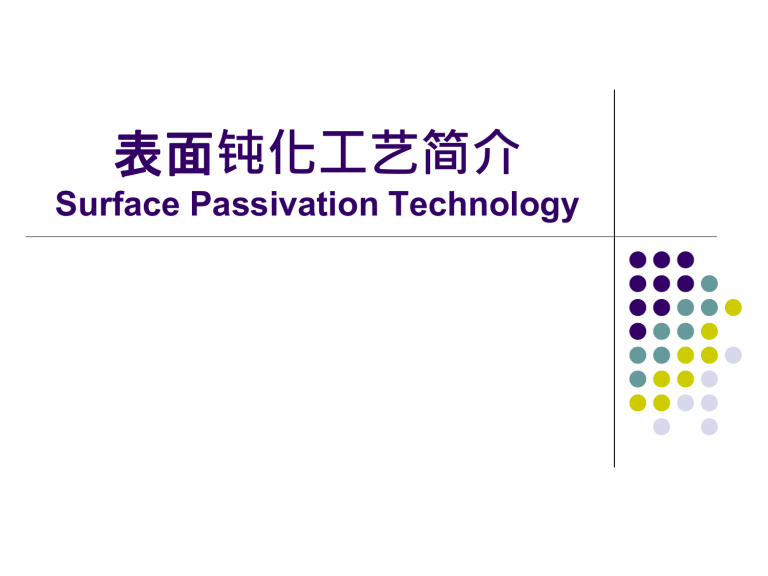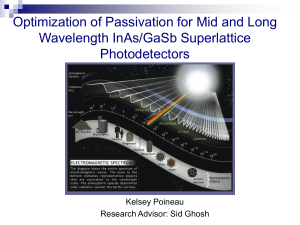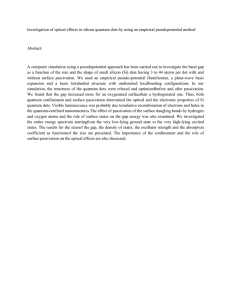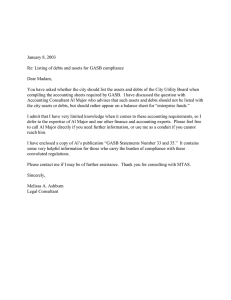
表面钝化工艺简介
Surface Passivation Technology
为什么要钝化?
半导体器件表面暴露在大气环境
中容易发生表面的氧化,形成很
高的表面和界面态密度,从而引
起费米能级钉扎和高表面复合速
度,形成表面寄生效应
半导体器件表面由于晶格失配形
成不饱和的悬挂键,以及由于表
面其他晶格的缺陷或表面吸附原
子,会在禁带中引入电子能级,
影响了半导
体器件的性
能和稳定性。
什么是钝化?
钝化工艺就是在半导体器件表面覆盖保护介质
膜,以防止表面污染的工艺。
首先要除去表面自然氧化层,然后在其表面引
入某种元素成分与样品本身的元素在表面形成
某种牢固的共价键,将表面态能级由禁带转移
到导带或价带中,从而改善其表面特性。
钝化的要求
电子特性方面:要求在钝化膜和半导体界面处
不存在界面态,并且在界面处有足够的势垒,
以阻止在器件工作时载流子进入钝化层;
化学特性方面,要求钝化膜能够保护界面,使
它在器件工作寿命内不会因温度和环境的影响
而退化;
钝化层的热膨胀系数与半导体器件相匹配;
膜的生长温度低;钝化膜的组份和厚度均匀性
好。
一些钝化的方法
热生长二氧化硅(SiO2 )膜。
磷硅玻璃 (PSG)、低温淀积二氧化硅、化学汽
相淀积氮化硅(Si3N4)、三氧化二铝(Al2O3)和
聚酰亚胺等多种表面钝化膜生长工艺。
多层钝化技术
外线超声/臭氧进行处理
干法钝化技术
S钝化
S2Cl2或S2Cl2/CCl4或CH3CSNH2/NH4OH溶液
处理
GaAs表面的S钝化方法
采用Na2S·9H20、(NH4)2S。、H2S和P2S5等硫
化物处理GaAs表面。
结果:GaAs表面态密度和载流子在表面复合
都有明显地减少,使得器件击穿电压增大、漏
电流减少、光致发光(PL)强度增强。但是硫钝
化后效果往往不稳定,特别是在有氧的大气环
境和光照的条件下,会导致钝化效果失效。
解决方法:在半导体表面生长一层绝缘,如
GaS。
钝化效果的检测
Title:Tailoring the photoluminescence characteristics of p-type GaSb: The role of
surface chemical passivation
Author:Bo Wang,Zhipeng Wei ,Mei Li, Guojun Liu, Yonggang Zou , Guozhong
Xing , Thiam Teck Tan,Sean Li, Xueying Chu, Fang Fang, Xuan Fang, Jinhua Li,
Xiaohua Wang, Xiaohui Ma
AFM
PL: a Nanometrics RPM2000 photoluminescence
spectrometer with a resolution of 0.2 mm
XPS: a Thermo ESCALAB 250 spectrometer
using monochromatised Al K source at energy of
1486.06 eV
钝化步骤
Un-doped p-type 500-um-thick GaSb and 8% (NH4)2S solution were
chosen in the present work.
First , The GaSb samples were first cleaved into 8 mm × 8 mm pieces and
soaked in acetone for 60 s to remove organic contaminants as well as the
natural oxide layer.
Then , aftre rinsing and drying procedure in advance , the samples were
numbered from1 to 9.
Sample 1 without any treatment ,The other samples from number 2 to 9
were soaked in (NH4)2S solution corrosive for 60, 120, 180, 240, 300, 360,
420and 480 s at 60 ℃, respectively.
Then , all samples rinsed in deionized (DI) water to remove sulfur crystal
and finally dried with the compressed N2 gas.
surface roughness
root mean square (RMS)
spatial resolved PL mapping
passivation process
The process of sulfide passivation
(a) breaking of bonds between Ga
and Sb, (b) chemical reaction, (c)
escape of an electron from the
semiconductor into the solution, (d)
formation of chemical bonds
between sulfur and atoms of the
semiconductor.
optical property
(a) During different sulfide passivation times, the relationship between emission energy and
light intensity is shown. The temperature of 8% ammonium sulfide is 60 ℃with pH value of 9.
Samples are soaked for 180, 240, 300 and 360 s. The intensity of pristine sample in (a) was
multiplied five times. All measurements were performed at 300 K. (b) Normalized PL peaks
intensity of samples with/without passivation treatment vs passivation time.
optical property
(a) 10 K PL spectra of the different passivation times of GaSb samples. The temperature of 8%
ammonium sulfide is 60 ℃, (b) logarithmic PL spectrum of GaSb sample at 10 K, passivated
for 300 s, with pH value of 9. Samples are soaked for 240, 300 and 360 s.
optical property
A:the transition of the conduction band to the native acceptor
level
B: the band-edge transition
Conclusion
the photoluminescence intensity of GaSb
with surface passivation was found to be 15
times higher than that of the pristine sample
the strongest luminous intensity was
achieved when the oxide layer was removed,
when the (NH ) S solution etched the surface of
GaSb and the edundant atoms of S cover
the surface, the luminous intensity decreased
sulfide improves GaSb luminous quality
significantly
4 2




